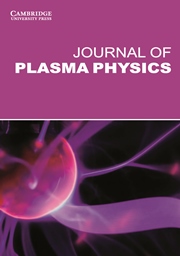Article contents
Sheared flow-driven vortices and solitary waves in a non-uniform plasma with negative ions and non-thermal distributed electrons
Published online by Cambridge University Press: 21 December 2012
Abstract
The coupled drift-ion acoustic (DIA) waves in an inhomogeneous magnetoplasma having negative and positive ions can be driven by the parallel sheared flows in the presence of Cairns distributed non-thermal electrons. The coupled DIA waves can become unstable due to shear flows. The conditions of modes instability are discussed with effects of non-thermal electrons. These are the excited modes and start interactions among themselves. The interaction is governed by the Hasegawa–Mima equations with analytical solutions in the form of a vortex chain and dipolar vortex. On the other hand, for scalar nonlinearity the Kortweg deVries-type equation is obtained with solitary wave solution. Possible application of the work to the space and laboratory plasmas are highlighted.
Information
- Type
- Papers
- Information
- Copyright
- Copyright © Cambridge University Press 2012
References
- 1
- Cited by

